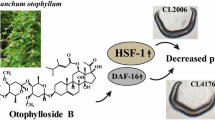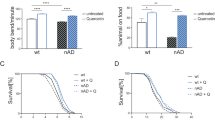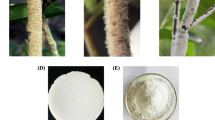Abstract
Cistanche deserticola has been found to exert protection against aging and age-related diseases, but mechanisms underlying its longevity effects remain largely unclear. Here, the multicellular model organism Caenorhabditis elegans was employed to identify lifespan extending and protective effects against β-amyloid (Aβ) induced toxicity by echinacoside (ECH), a phenylethanoid glycoside isolated from C. deserticola. Our results showed that ECH extends the mean lifespan of worms and increases their survival under oxidative stress. Levels of intracellular reactive oxygen species and fat accumulation were also significantly suppressed by ECH. Moreover, ECH-mediated lifespan extension was found to be dependent on mev-1, eat-2, daf-2, and daf-16, but not sir-2.1 or hsf-1 genes. Furthermore, ECH triggered DAF-16 nuclear localization and upregulated two of its downstream targets, sod-3 and hsp-16.2. In addition, ECH significantly improved the survival of CL4176 worms in response to proteotoxic stress induced by Aβ protein aggregation. Collectively, these findings suggested that reactive oxygen species scavenging, dietary restriction, and insulin/insulin-like growth factor signaling pathways could be partly involved in ECH-mediated lifespan extension. Thus, ECH may target multiple longevity mechanisms to extend lifespan and have a potency to prevent Alzheimer’s disease progression.
Graphical Abstract













Similar content being viewed by others

References
Abbas S, Wink M (2009) Epigallocatechin gallate from green tea (Camellia sinensis) increases lifespan and stress resistance in Caenorhabditis elegans. Planta Med 75(3):216–221
Altintas O, Park S, Lee SJ (2016) The role of insulin/IGF-1 signaling in the longevity of model invertebrates, C. elegans and D. melanogaster. BMB Rep 49(2):81–92
Bamps S, Wirtz J, Savory FR, Lake D, Hope IA (2009) The Caenorhabditis elegans sirtuin gene, sir-2.1, is widely expressed and induced upon caloric restriction. Mech Ageing Dev 130(11–12):762–770
Bargmann CI, Hartwieg E, Horvitz HR (1993) Odoramt-selective genes and neurons mediate olfaction in C. elegans. Cell 74(3):515–527
Brenner S (1974) The genetics of Caenorhabditis elegans. Genetics 77(1):71–94
Cai RL, Yang MH, Shi Y, Chen J, Li YC, Qi Y (2010) Antifatigue activity of phenylethanoid-rich extract from Cistanche deserticola. Phytother Res 24:313–315
Chen M, Müller D, Richling E, Wink M (2013) Anthocyanin-rich purple wheat prolongs the life span of Caenorhabditis elegans probably by activating the DAF-16/FOXO transcription factor. J Agric Food Chem 61:3047–3053
Chen YJ, Brian O, Chen HZ, Xiao SY, Liu XJ, Monica D, Cao Y (2014) Huang, Q. R. Mechanism of longevity extension of Caenorhabditis elegans induced by pentagalloyl glucose isolated from Eucalyptus leaves. J Agric Food Chem 62:3422–3431
China Pharmacopoeia Committee (2010) Chinese pharmacopoeia, vol I. China Medical Science and Technology Press, Beijing, p 126
Donato V, Ayala FR, Cogliati S, Bauman C, Costa JG, Lenini C, Grau R (2017) Bacillus subtilis biofilm extends Caenorhabditis elegans longevity through downregulation of the insulin-like signalling pathway. Nat Commun 14332(8):1–15
Douglas PM, Baird NA, Simic MS, Uhlein S, McCormick MA, Wolff SC, Kennedy BK, Dillin A (2015) Heterotypic signals from neural HSF-1 separate thermotolerance from longevity. Cell Rep. 12:1196–1204
Fabian TJ, Johnson TE (1994) Production of age-synchronous mass cultures of Caenorhabditis elegans. J. Gerontol. 49(4):145–146
Finkel T, Holbrook NJ (2000) Oxidants, oxidative stress and the biology of ageing. Nature 408(6809):239–247
Fu GM, Pang HH, Wong YH (2008) Naturally occurring phenylethanoid glycosides: potential leads for new therapeutics. Curr Med Chem 15(25):2592–2613
Guarente L, Picard F (2005) Calorie restriction–the SIR2 connection. Cell 120(4):473–482
Guo YH, Cao LL, Zhao QS, Zhang LJ, Chen JJ, Liu BY, Zhao B (2016) Preliminary characterizations, antioxidant and hepatoprotective activity of polysaccharide from Cistanche deserticola. Int J Biol Macromol 93:678–685
Hesp K, Smant G, Kammenga JE (2015) Caenorhabditis elegans DAF-16/FOXO transcription factor and its mammalian homologs associate with age-related disease. Exp. Gerontl. 72:1–7
Honda Y, Tanaka M, Honda S (2010) Trehalose extends longevity in the nematode Caenorhabditis elegans. Aging Cell 9:558–569
Hsu AL, Murphy CT, Kenyon C (2003) Regulation of aging and age-related disease by DAF-16and heat-shock factor. Science 300(5622):1142–1145
Huang C, Xiong C, Kornfeld K (2004) Measurements of age-related changes of physiological processes that predict lifespan of Caenorhabditis elegans. Proc Natl Acad Sci USA 101(21):8084–8089
Ishii N, Fujii M, Hartman PS, Tsuda M, Yasuda K, Senoo-Matsuda N, Yanase S, Ayusawa D, Suzuki K (1998) A mutation in succinate dehydrogenase cytochrome b causes oxidative stress and ageing in nematodes. Nature 394(6694):694–697
Jiang Y, Tu PF (2009) Analysis of chemical constituents in Cistanche species. J Chromatogr A 1216:1970–1978
Jiang JC, Jaruga E, Repnevskaya MV, Jazwinski SM (2000) An intervention resembling caloric restriction prolongs life span and retards aging in yeast. FASEB J 14(14):2135–2137
Jiang TF, Sun Q, Chen SD (2016) Oxidative stress: a major pathogenesis and potential therapeutic targetof antioxidative agents in Parkinson’s disease and Alzheimer’s disease. Prog Neurobiol 147:1–19
Kaletta T, Hengartner MO (2006) Finding function in novel targets: C. elegans as a model organism. Nat Rev Drug Discov 5:387–399
Kampkotter A, Timpel C, Zurawski RF, Ruhl S, Chovolou Y, Proksch P, Watjen W (2008) Increase of stress resistance and lifespan of Caenorhabditis elegans by quercetin. Comp Biochem Phys B 149(2):314–323
Kannan K, Fridell YW (2013) Functional implications of Drosophila insulin-like peptides in metabolism, aging, and dietary restriction. Front Physiol 4:288
Kenyon CJ (2010) The genetics of ageing. Nature 464(7288):504–512
Lakowski B, Hekimi S (1998) The genetics of caloric restriction in Caenorhabditis elegans. Proc Natl Acad Sci USA 95(22):13091–13096
Larsen PL (1993) Aging and resistance to oxidative damage in Caenorhabditis elegans. Proc Natl Acad Sci USA 90(19):8905–8909
Li L, Tsao R, Yang R, Liou C, Young JC, Zhu H (2008) Isolation and purification of phenylethanoid glycosides from Cistanche deserticola by high-speed counter-current chromatography. Food Chem 108(2):702–710
Lin LW, Hsieh MT, Tsai FH, Wang WH, Wu CR (2002) Anti-nociceptive and anti-inflammatory activity caused by Cistanche deserticola in rodents. J Ethnopharmacol 83:177–182
Luo Y (2006) Alzheimer’s disease, the nematode Caenorhabditis elegans, and ginkgo biloba leaf extract. Life Sci 78(18):2066–2072
Matsuura T, Oikawa T, Wakabayashi T, Shingai R (2004) Effect of simultaneous presentation of multiple attractants on chemotactic response of the nematode Caenorhabditis elegans. Neurosci Res 48(4):419–429
McKay JP, Raizen DM, Gottschalk A, Schafer WR, Avery L (2004) eat-2 and eat-18 are required for nicotinic neurotransmission in the Caenorhabditis elegans pharynx. Genetics 166(1):161–169
Morimoto RI (2008) Proteotoxic stress and inducible chaperone networks in neurodegenerative disease and aging. Gene Dev 22(11):1427–1438
Morley JF, Morimoto RI (2004) Regulation of longevity in Caenorhabditis elegans by heat shock factor and molecular chaperones. Mol Biol Cell 15:657–664
Mukhopadhyay A, Oh SW, Tissenbaum HA (2006) Worming pathways to and from DAF-16/FOXO. Exp Gerontl 41(10):928–934
Murphy CT, McCarroll SA, Bargmann CI, Fraser A, Kamath RS, Ahring J, Li H, Kenyon C (2003) Genes that act downstream of DAF-16 to influence the lifespan of Caenorhabditis elegans. Nature 424(6946):277–283
Nan ZD, Zeng KW, Shi SP, Zhao MB, Jiang Y, Tu PF (2013) Phenylethanoid glycosides with anti-inflammatory activities from the stems of Cistanche deserticola cultured in Tarim desert. Fitoterapia 89:167–174
Nan ZD, Zhao MB, Zeng KW, Tian SH, Wang WN, Jiang Y, Tu PF (2016) Anti-inflammatory iridoids from the stems of Cistanche deserticola cultured in Tarim Desert. Chin J Nat Med 14(1):61–65
Pan MH, Lai CS, Tsai ML, Wu JC, Ho CT (2012) Molecular mechanisms for anti-aging by natural dietary compounds. Mol Nutr Food Res 56:88–115
Raynes R, Leckey BD, Nguyen K, Westerheide SD (2012) Heat shock and caloric restriction have a synergistic effect on the heat shock response in a sir2.1-dependent manner in Caenorhabditis elegans. J Biol Chem 287(34):29045–29053
Singh SP, Niemczyk M, Zimniak L, Zimniak P (2008) Fat accumulation in Caenorhabitis elegans triggered by the electrophilic lipid peroxidation product 4-hydroxynonenal (4-HNE). Aging 1:68–80
Su S, Wink M (2015) Natural lignans from Arctium lappa as antiaging agents in Caenorhabditis elegans. Phytochemistry 117:340–350
Testa G, Biasi F, Poli G, Chiarpotte E (2014) Calorie restriction and dietary restriction mimetics: a strategy for improving healthy aging and longevity. Curr Pharm Des 20(18):2950–2977
Walker G, Houthoofd K, Wanfleteren JR, Gems D (2005) Dietary restriction in C. elegans: from rate-of-living effects to nutrient sensing pathways. Mech Ageing Dev 126(9):929–937
Wang X, Zhang J, Lu L, Zhou L (2015) The longevity effect of echinacoside in Caenorhabditis elegans mediated through daf-16. Biosci Biotechnol Biochem 79(10):1676–1683
Wat E, Ng CF, Koon CM, Wong EC, Tomlinsin B, Lau CB (2016) The protective effect of Herba Cistanches on statin-induced myotoxicity in vitro. J Ethnopharmacol 190:68–73
Wu Y, Wu Z, Butko P, Christen Y, Lambert MP, Klein WL, Luo Y (2006) Amyloid-beta-induced pathological behaviors are suppressed by Ginkgo biloba extract EGb 761 and ginkgolides in transgenic Caenorhabditis elegans. J Neurosci 26(50):13102–13113
Zhang K, Ma X, He W, Li H, Han S, Jiang Y, Wu H, Han L, Ohno T, Uotsu N, Yamaguchi K, Ma Z, Tu P (2014) Extracts of Cistanche deserticola can antagonize immunosenescence and extend lifespan in senescence-accelerated mouse prone 8 (SAM-P8) mice. Evid Based Complement Alternat Med 2014:601383
Acknowledgements
The authors thank the CGC Center (Minneapolis, MN, USA) and Prof. J. Fei at Tongji University for providing the worm culture. Financial support from the National Natural Science Foundation (Grant no. 31670347, 81001369 and 31170327), Shanghai Science and Technology Commission of Shanghai Municipality (No. 15401901000) is gratefully acknowledged.
Author information
Authors and Affiliations
Corresponding author
Electronic supplementary material
Below is the link to the electronic supplementary material.
Rights and permissions
About this article
Cite this article
Chen, W., Lin, HR., Wei, CM. et al. Echinacoside, a phenylethanoid glycoside from Cistanche deserticola, extends lifespan of Caenorhabditis elegans and protects from Aβ-induced toxicity. Biogerontology 19, 47–65 (2018). https://doi.org/10.1007/s10522-017-9738-0
Received:
Accepted:
Published:
Issue Date:
DOI: https://doi.org/10.1007/s10522-017-9738-0



